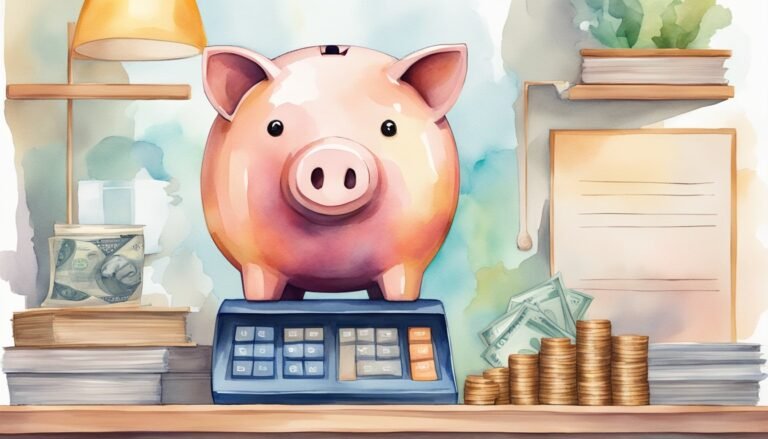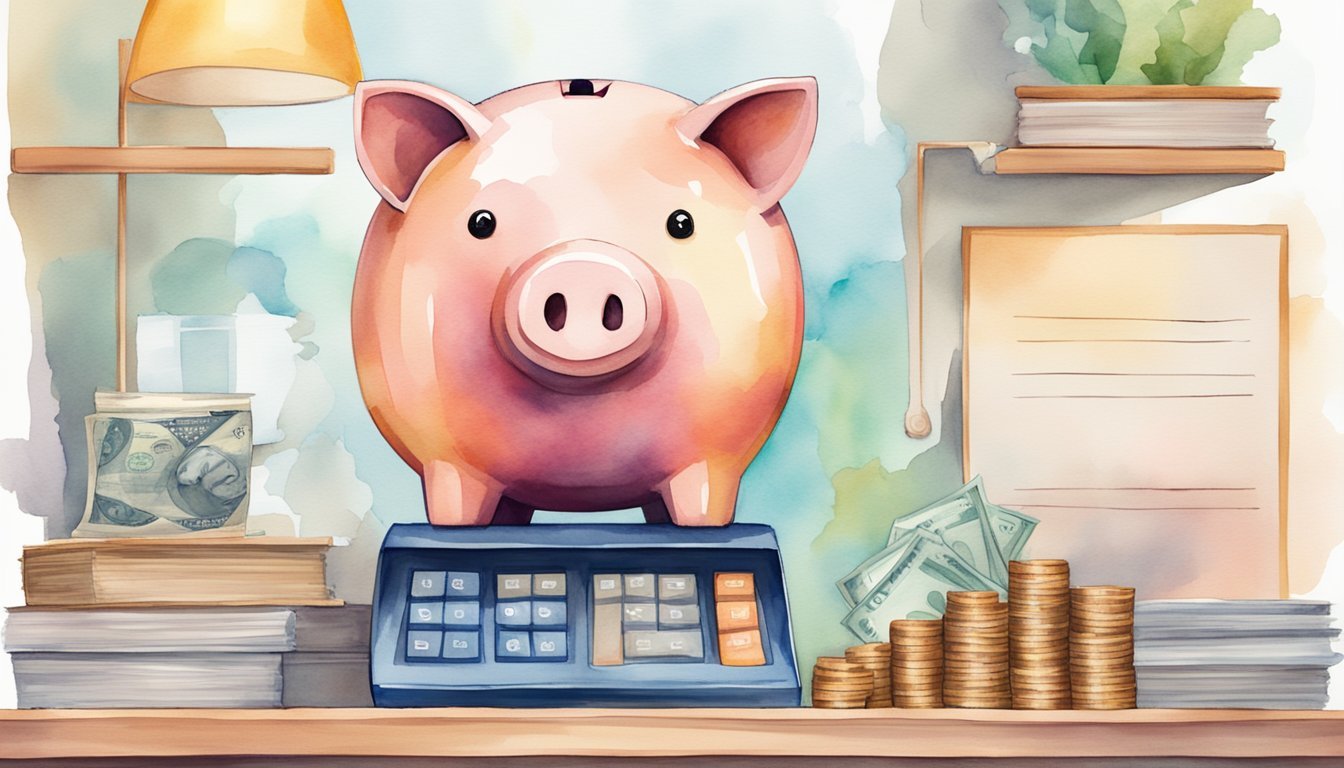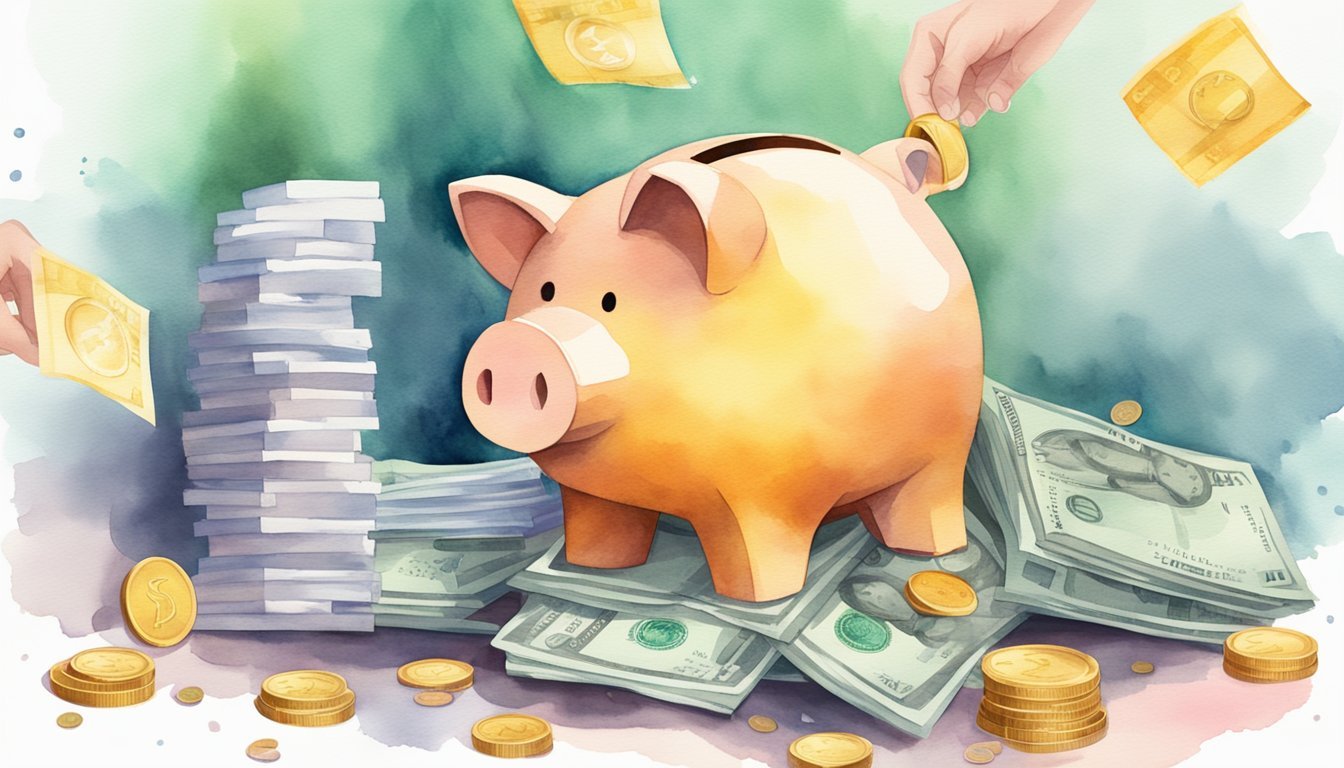How to Save for a Down Payment on a House: Quick and Easy Tips

Saving for a down payment on a house may seem like a big challenge, but with the right plans and strategies, you can make it happen.
Whether you’re looking to buy your first home or upgrade to a larger one, having a clear goal and a solid savings plan is essential.

Understanding how to save for a down payment can help you get one step closer to your dream home. From adjusting your budget to finding extra sources of income, there are many ways to build up your savings.
This guide will explore some effective tips that can make the process smoother and more manageable.
1) Set up a dedicated savings account

Having a dedicated savings account just for your down payment can make a big difference.
It helps you stay organized and keeps you from accidentally spending your down payment money on other things.
You’ll want to open this account at a bank or credit union that you trust.
Make sure it doesn’t have high fees.
Consider setting up automatic transfers from your main checking account to this new savings account.
This will help you save without even thinking about it.
Even small, regular deposits can add up over time.
Look for accounts that offer higher interest rates.
High-yield savings accounts can grow your money faster than regular savings accounts.
Having a separate account also makes it easier to track your progress.
You can see your savings grow and feel more motivated to reach your goal.
If you need advice on how to save even more, you can read some practical strategies online.
In some cases, you might find special savings programs designed for first-time homebuyers.
These programs sometimes offer bonuses or match contributions, making it easier to save up for your down payment.
Setting up a dedicated savings account is a simple yet powerful step in your home-buying journey.
It keeps your goal in sight and keeps your money growing.
2) Automate your savings
Setting up automatic transfers can make saving for a down payment a breeze.
You can arrange for a portion of your paycheck to go directly into a separate savings account.
This way, you’re saving without even thinking about it.
Automating your savings helps reduce the temptation to spend that money.
When the funds are transferred automatically, you’re less likely to miss them or consider them part of your spending budget.
Using a high-yield savings account can make the process even better.
With a high-yield savings account, your money grows faster thanks to higher interest rates.
Treat your savings goal like a bill.
Schedule the automatic transfer just like you would pay a monthly utility bill.
Consistency is key here, and automating helps you stay on track.
Start with an amount you’re comfortable with.
Even small contributions can add up over time.
As you get used to it, you can gradually increase the amount you save.
To sum up, automating your savings is a simple and effective way to make sure you’re consistently setting money aside for your down payment.
3) Cut out Non-Essential Expenses
Take a close look at your spending habits.
Sometimes, it’s easy to overlook small expenses that add up over time.
Try skipping that daily coffee run or cooking at home instead of eating out.
Think about your subscriptions.
Do you really need all of them? Canceling a few can save a lot each month.
Entertainment expenses can also be reduced.
Instead of going to the movies, consider having a movie night at home.
Borrow books from the library instead of buying new ones.
Review your utility usage.
Turn off lights when not in use and unplug electronics.
Small changes in your energy habits can save money on your bills.
When shopping for clothes or gadgets, wait for sales.
Better yet, ask yourself if you truly need the item before buying it.
Using coupons and taking advantage of discounts can also help.
Look for deals online and in-store.
Cutting out non-essential expenses isn’t just about saving money.
It’s about making smarter choices with your finances.
This way, you’ll reach your down payment goal faster.
Reducing unnecessary spending can make a big difference in your savings over time.
4) Create a budget and stick to it
Setting up a budget is a crucial step when saving for a down payment.
Start by listing your financial goals.
Knowing what you want to achieve helps guide your budgeting efforts.
Next, write down all your sources of income.
This includes your regular salary, any side jobs, or other streams of revenue.
Being aware of your total income is key.
Then, track your expenses.
Look at your spending habits.
Record everything from bills and groceries to entertainment.
This will help you see where your money goes and where you can make cuts.
Adjust your spending.
After tracking your expenses, you may find areas where you can reduce spending.
Cutting back on non-essential items can help you save more money each month.
Automate your savings.
Set up automatic transfers to a savings account.
This way, a portion of your income goes directly into your down payment fund.
It helps you save consistently without even thinking about it.
Monitor your progress.
Keep an eye on your budget to make sure you’re sticking to it.
Adjust it as needed to stay on track with your savings goals.
Celebrate small wins.
Each time you reach a savings milestone, celebrate it.
This can motivate you to keep going and make the process more enjoyable.
Stay disciplined.
Sticking to a budget requires commitment.
Remind yourself of your goals regularly to stay focused.
For more detailed steps on creating a budget, check out how to create a budget and stick to it.
5) Sell unused items
Selling unused items is a great way to make extra money for your down payment.
Look around your home for things you no longer need or use.
From old clothes and electronics to furniture and books, there’s probably a lot you can sell.
Take clear photos and write honest descriptions of your items.
Online platforms like eBay, Craigslist, and Facebook Marketplace make it easy to reach a wide audience.
Pricing your items reasonably will help them sell faster.
Don’t forget about local consignment shops or garage sales.
These can be good options for selling items that are harder to ship.
You might be surprised at how much you can make from things you’ve forgotten about.
Every little bit adds up!
Decluttering your space can also make your home feel more organized and less stressful.
It’s a win-win situation.
You make extra money and create a cleaner living space.
6) Pick up a side hustle
Picking up a side hustle is a great way to save for a house down payment.
Adding an extra income stream can accelerate your savings.
Consider a part-time job at a local cafe or shop.
Even a few hours a week can make a difference.
If you have skills like graphic design or writing, freelancing can bring in extra cash.
Websites like Upwork or Fiverr are good places to start.
Selling handmade goods or crafts online is another option.
Platforms like Etsy or eBay can help turn your hobbies into extra money.
Think about driving for a rideshare company like Uber or Lyft.
The flexibility lets you work around your main job.
Babysitting, pet sitting, or dog walking are also easy side gigs.
Apps like Rover connect you with pet owners in your area.
Lastly, if you’re good at tutoring, offer your services to students.
Subjects like math or science are always in demand.
Each small job adds up.
Over time, you’ll see your down payment savings grow faster than expected.
Try different options until you find what fits your schedule and skills.
7) Benefit from Employer Savings Programs
Some companies offer savings programs that can help you with your down payment.
These programs might include bonuses, profit-sharing, or retirement account matches.
A lot of these savings programs allow you to divert a portion of your salary to a savings fund.
This can really add up over time.
It’s worth asking your HR department if such options are available.
Employer Assisted Housing (EAH) programs are also becoming more common.
These programs provide funds for your down payment and closing costs as a loan that gets forgiven over time.
By participating, you could potentially save thousands on your home.
Consider using any bonuses or profit-sharing payouts directly for your down payment.
This way, you can make significant progress without changing your regular budget.
Check if your employer offers a match on your retirement savings.
You can contribute to your retirement account, and then withdraw those matched funds early to help with your home purchase.
This can be a smart way to leverage what’s already offered to you.
Don’t forget to explore all the benefits your workplace offers.
Your job can be a valuable resource in reaching your goal of homeownership.
8) Reduce High-Interest Debt

Paying off high-interest debt can help you save more for a down payment.
Credit cards, with their high interest rates, should be the first target.
By reducing this debt, you will have more money to put towards your home savings.
Create a plan to pay off these debts.
Focus on paying off the card with the highest interest rate first.
This method is often called the avalanche method.
It saves you the most money in interest over time.
Seek lower interest rates if possible.
You might consider consolidating your debts into a single loan with a lower rate.
This can make it easier to manage your payments and reduce the overall cost of your debt.
Use unexpected funds wisely.
If you get a bonus, tax refund, or any extra cash, use it to pay down high-interest debt.
It may be tempting to spend it elsewhere, but reducing debt will help you save more in the long run.
Track your progress.
Keeping an eye on how much debt you’ve paid off can be really motivating.
Celebrate small victories along the way to keep yourself motivated.
Avoid taking on new high-interest debt.
Try to limit the use of credit cards.
If you do use a card, make sure to pay off the balance in full each month.
This way, you can avoid interest charges.
By focusing on reducing high-interest debt, you can free up more of your finances for saving towards your new home.
9) Save Windfalls and Tax Refunds
Unexpected money like tax refunds, bonuses, or monetary gifts can boost your savings quickly.
Instead of spending it, put it directly into your down payment fund.
You might get a tax refund every year.
This money can make a significant difference in your savings goal.
It’s often a lump sum, so it feels like a big leap forward.
Work bonuses often come as a surprise.
When you get one, plan to save that extra income.
It’s money you didn’t expect, so saving it doesn’t change your usual spending habits.
Monetary gifts from family or friends can also add up.
During holidays or birthdays, you may get financial gifts.
Add these to your savings instead of spending them.
Every bit counts when you’re saving for a house.
These unexpected funds can increase your savings faster than you think.
If you get a work bonus, think about how that money can push you closer to your home-buying goal.
It’s tempting to spend it on something fun, but putting it aside can pay off in the long run.
For more info, check out how directing unexpected windfalls into your house down payment fund can improve your financial situation and significantly increase your savings at The Mortgage Reports.
10) Take Advantage of First-Time Homebuyer Programs
First-time homebuyer programs are designed to help people like you get into their first home.
These programs usually offer lower down payments, making it easier to secure a mortgage without having a huge amount of savings.
For example, the Fannie Mae HomeReady program allows you to make a down payment as low as 3%.
This can be a big help if saving up a large down payment seems daunting.
There are different types of assistance available.
Some programs offer loans that must be repaid, while others provide grants that don’t need to be paid back.
Check out Zillow’s guide on down payment assistance to see what options you have.
Interest-free loans and forgiving loans are also available through some first-time homebuyer programs.
These can ease the financial burden and speed up the process of buying your home.
Each state and local government often have their own programs too.
So, researching your specific area could reveal additional opportunities.
Visit Forbes’ guide to down payment assistance to learn more about the different types of help you can receive.
Using these programs can make owning your first home a reality sooner than you might have thought.
They are definitely worth exploring as you plan your path to homeownership.
Understanding the Basics
Before you start saving for a down payment, it’s crucial to know why it matters and how much you should aim to save.
These are the key parts of getting prepared to buy a house.
Why a Down Payment Matters
A down payment is the initial amount you pay when buying a house.
It reduces the loan amount you need.
The bigger your down payment, the lower your monthly mortgage payments will be.
It also shows lenders that you are serious and financially stable.
Down payments help avoid private mortgage insurance (PMI).
If you put down at least 20%, you usually skip this extra cost.
PMI can add $30 to $70 per month for every $100,000 borrowed.
Saving for a down payment helps you assess your financial habits.
By setting money aside consistently, you build good saving habits, which are useful throughout homeownership.
How Much Should You Save?
How much you should save depends on the price of the house you want and the percentage you plan to put down.
Typically, the down payment is between 3% and 20% of the home’s price.
Calculate your needs.
For a $300,000 house, 3% is $9,000, while 20% is $60,000.
Also, include closing costs and moving expenses.
Closing costs are usually 2-5% of the home’s price.
Use a savings plan.
Setting aside a fixed amount every month helps you reach your goal.
Consider using a high-yield savings account to earn interest on your savings.
You might also explore additional income sources for a boost.
Financial Planning Tips
To save for a down payment on a house, you need to focus on making a manageable budget and cutting back on debt.
This will help you allocate more funds to your down payment savings.
Creating a Budget
Start by listing all your monthly income sources.
This includes your salary, any freelance work, and other income streams.
Next, write down your expenses, such as rent, utilities, groceries, and entertainment.
Use a budgeting tool or app to track your spending.
Allocate a fixed amount to your savings each month.
Consider setting up an automatic transfer to your savings account specifically for your down payment.
Identify areas where you can cut back.
Maybe skip that daily coffee run or dine out less often.
This will free up more money for your down payment fund.
Reducing Debt
Paying down debt can significantly improve your ability to save.
Start by listing all your debts, including credit cards, student loans, and personal loans.
Prioritize paying off high-interest debt first.
This will reduce the amount of interest you pay over time, freeing up more money for savings.
Consider consolidating your debts to get a lower interest rate.
Try the debt snowball or avalanche method.
With the debt snowball method, focus on paying off the smallest debts first, giving you quick wins.
With the debt avalanche method, target the debts with the highest interest rates first.
Choose the method that works best for you to reduce your debt effectively.
Smart Saving Strategies
Smart saving strategies can make all the difference in achieving your down payment goals.
Key tactics include automating your savings, choosing high-interest savings accounts, and utilizing tax-advantaged accounts.
Automating Your Savings
Setting up automatic transfers can help you save without thinking about it.
By arranging for a fixed amount to be moved from your checking to your savings account each month, you ensure consistency.
It’s an effortless way to build your savings over time.
This method also helps in avoiding the temptation to spend that money elsewhere.
You can even set up multiple savings buckets for different goals.
Some banks and apps offer “round-up” features that round up your purchase amounts and transfer the difference to savings.
You won’t notice the small amounts, but they add up fast.
Exploring High-Interest Savings Accounts
A high-interest savings account can make your money grow quicker.
Unlike regular savings accounts, high-interest accounts offer a better return on your savings.
Look for accounts with no fees and good interest rates.
Online banks often provide higher interest because they don’t have the same overhead costs as traditional banks.
Compare different savings accounts to find one that suits your needs.
You can use comparison tools online to see which banks currently offer the best rates.
Remember, higher interest can make a big difference when saving for big goals like a house down payment.
Making Use of Tax-Advantaged Accounts
Tax-advantaged accounts such as IRAs and 401(k)s can also play a role in your saving strategy.
Certain accounts allow you to withdraw money penalty-free for a first-time home purchase.
For example, the IRS allows first-time homebuyers to withdraw up to $10,000 from a traditional IRA without penalty.
Make sure to understand the rules and potential tax implications.
These accounts also often come with benefits like employer matching for 401(k)s, which can boost your savings even more.
By wisely using these options, you can maximize your savings and better prepare for your home purchase.
Frequently Asked Questions
Saving for a house down payment is a big task.
You might have questions about quick savings strategies, how much you need to save, and the best places to keep your growing savings.
What’s the best way to save for a house down payment quickly?
Set up a dedicated savings account specifically for your down payment.
Automating your savings can also help you consistently put aside money without thinking about it.
Pay yourself first by setting up automatic transfers right after you get paid.
Are there any tricks for saving a house down payment in under a year?
Cut out non-essential expenses and dedicate that money to your down payment fund.
Selling unused items around your home can also give you a quick boost.
Some people pick up side gigs or freelance work to increase their income.
How much do I need to put down on a house, and is less than 20% okay?
While a 20% down payment helps you avoid private mortgage insurance (PMI), it’s possible to buy a house with less than that.
Some lenders offer loans with as little as 3% down.
Be sure to check the requirements and benefits of each option.
Got $10k saved up; is that enough to put down on a house?
$10,000 could be a decent down payment depending on the home price and loan type.
For a $200,000 house, it represents a 5% down payment.
Explore different loan options and talk with a mortgage advisor.
Can you recommend where to keep my savings while I’m building a down payment for a home?
Keep your savings in a high-yield savings account to earn some interest while you save.
Money market accounts can also be a good option.
Avoid investing in high-risk stocks or funds if your goal is short-term.
Just got two years to save for a house—any tips on how to budget?
Create a detailed budget and stick to it.
Track your spending to find areas where you can cut back.
Set a specific savings target for each month.
Automate your savings transfers to ensure you stay on track and avoid unnecessary expenses.

